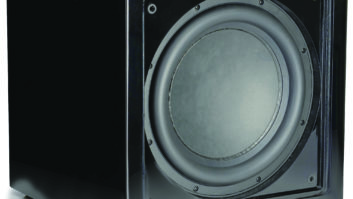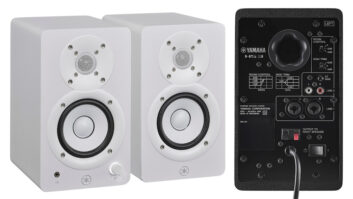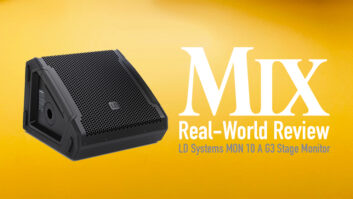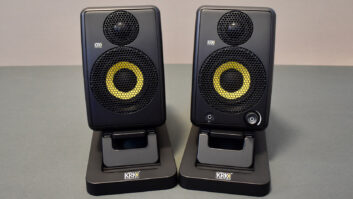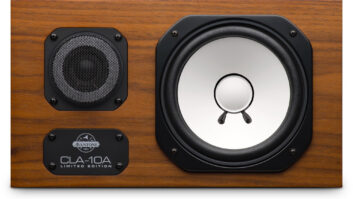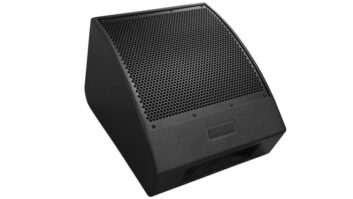When Yamaha discontinued production of its venerable NS-10M studio monitor due to unavailable parts, mix engineers worldwide were left with a dilemma: How do you replace what has arguably been the most reliable proxy for consumer-playback systems for the past two decades? Mixes that sounded right on that speaker would almost invariably translate well to low-end consumer setups.
Although I’ve searched for a suitable replacement for my aging NS-10Ms, I could never find a monitor that worked nearly as well in this capacity — until now. The Yamaha HS50M powered near-field is the new go-to consumer-playback reference. Adding the companion Yamaha HS10W active sub yields a full-bandwidth monitoring system, helping to ensure your mixes’ bottom two octaves will also be in proper perspective.
CLASSIC WHITE CONE
The HS50M’s black MDF cabinet measures 10.56×6.5×8.75 inches (H×W×D, roughly two-thirds the size of an NS-10M), weighs only 12.8 pounds and sports a white woofer cone that pays homage to the classic NS-10M. The 5-inch woofer is powered by a built-in 45-watt amplifier, while the 0.75-inch tweeter receives 25W power from a second built-in amp. When power is applied to the HS50M, an attractive tuning fork emblem on the bottom-front cabinet face becomes backlit by a white LED. The magnetically shielded cabinet sports radiused side edges and a rear-firing bass port.
The HS50M’s rear cabinet face features a wide-ranging sensitivity control, power switch and IEC power connector that serves a detachable three-prong AC cord. The continuously variable, rotary sensitivity control is detented at the +4dB position and can also accommodate -10dB systems.
Two input connectors — XLR and bal-anced/unbalanced TRS — and four switchable filters also grace the monitor’s rear panel. A low-cut (12dB per octave HPF) switch offers a selection of 80Hz or 100Hz corner frequencies, or flat response to optimize integration with the HS10W or other subwoofer. A Room Control switch selects among 0, -2 and -4dB settings for shelving EQ below 500 Hz; it can help flatten response when the monitors are placed too close to walls or corners. A Mid-EQ switch boosts or cuts 2 dB around 2 kHz with a bell-curve filter or selects flat response in this band. Also, a three-way high trim switch boosts or cuts 2 dB above 3 kHz using shelving EQ or selects flat response for highs. With all filters set for flat response, the HS50M’s stated frequency response is 55 to 20k Hz, -10 dB. (It does not specify 3dB down points.)
BIG BOTTOM
The HS10W sub weighs roughly 27.5 pounds and measures 13.8×11.8×15.2 inches. The sub features an 8-inch downfiring woofer protected by a grille and is powered by a built-in 150W amp. A flared bass-reflex port fires out of the front of the black MDF cabinet and is situated above the same distinctive, backlit tuning fork emblem.
Situated above the HS10W’s hefty heat sink on the sub’s rear panel are XLR and balanced/unbalanced TRS jacks that serve both left- and right-channel inputs. An Ext Sub Out (XLR) connector sums the left- and right-channel inputs and is useful for feeding a second subwoofer. Left and right outputs are provided on XLRs; I wish that TRS jacks were also provided to match the HS50M’s input offerings.
A continuously variable, rotary low-cut control rolls off bass response below a selected frequency from 80 to 120 Hz when activated by a companion on/off switch. Another continuously variable rotary control — labeled High Cut — rolls off bass response above a selected frequency from 80 to 120 Hz. With all filters set for flat response, the HS10W’s stated frequency response is 30 to 180 Hz, -10 dB.
Also on the rear panel, a continuously variable, rotary level control helps balance the HS10W’s output level with that of your satellite speakers. A Phase switch can flip the sub’s polarity 180 degrees, if necessary, to align it properly with your satellites’ bass output. A power switch and IEC power connector (the latter for a detachable AC power cord) round out the rear panel.
PASSING THE TEST
I set up a pair of HS50Ms on Auralex MoPADs (foam decouplers) situated on the monitor shelves of an Omnirax MixStation 02R and placed the HS10W in the footwell below. I was a little disappointed that the XLR connectors on the review units didn’t latch, which would have been a nice safety feature. Happily, I heard no thumps or clicks when power cycling the monitors or moving any of the filter switches, even with my Yamaha 02R’s control room feed turned up.
I was also happy that the level controls for the HS50M and HS10W could attenuate signal down to minus infinity (silence). Muting the sub’s output allowed me to listen to the HS50Ms alone as a consumer-system proxy. I wish that the HS10W had a bypass jack and remote switch that would mute its output (but not the pass-through signal for the satellites) so I could have retained the HS10W’s level setting and switched back and forth between consumer-playback reference and full-bandwidth monitoring.
I first listened to a variety of country, pop and techno releases to get to know the monitors. As compared to my NS-10M studio monitors, the HS50M — with all EQ settings flat and the HS10W silenced — produced a leaner-sounding upper-bass/low-midrange band, much more extended highs and dramatically improved (make that outstanding) transient response, imaging and depth. Most importantly, the HS50M produced no audible upper-bass resonances from being mounted on console-top shelving; unlike virtually all other near-field monitors I’ve heard positioned this way, the HS50M still sounded absolutely crystal-clear.
Next, I proceeded to mix a 43-track country/pop song using only the HS50M and HS10W. When I turned up the HS10W’s output, the upper-bass frequencies for the combined system sounded a little muddy until I set the sub’s high-cut control and the HS50M’s low-cut switches to 80 Hz to preclude overlap in bass response. With that accomplished, the bass tightened up, the mix became eminently clear and the overall system yielded all the low-end extension, prominence and punch to attain the proper balance for the mix’s bottom two octaves.
The HS50M can be fatiguing at high listening levels; female vocals, in particular, can sometimes sound cutting, but listening at low levels cures this. Attenuating the monitors’ high trim or mid-EQ response warmed up the overall sound, but to the detriment of detail and clarity. With flat midrange and high-frequency filter settings, the detail these near-fields reveal in the critical midrange band is downright awesome.
The HS50M’s very diminutive size and lean bass sound allowed me to easily size up and fine-tune relative levels for vocals, electric guitars and other midrange elements. The only surprise I heard when listening back to my mix on various consumer systems was that the female lead vocal sounded a little boomy. The HS50M’s response was apparently a tad too lean in the upper-bass band, prompting me to add too much EQ boost there. Everything else sounded perfect, though, and the adjustments I made on a second mix pass fixed the problem.
PASSING THE TEST
The HS50M would be my first choice (among current production models) for a band-limited mix reference mounted atop a console. Similar to the NS-10M, the HS50M makes it easy to balance levels for a mix’s midrange elements. Unlike the NS-10M, the HS50M readily reveals vocal sibilance and cymbals that are EQ’d too crisply. The HS50M provides a nearly perfect reference for how a mix will sound on small consumer-playback systems and is a veritable bargain at $249.95 MSRP (sold singly). Add the perfectly matched HS10W ($599 MSRP) to the setup, and you have an excellent full-bandwidth system.
Yamaha, 714/522-9011, www.yamahaproaudio.com.
Michael Cooper owns Michael Cooper Recording in beautiful Sisters, Ore.
I also briefly worked with the HS80M, big brother to the HS50M reviewed here. The HS80M produced significantly more bass and low mids compared to the HS50M, but both models had essentially the same bright top end. The HS50M produced better imaging, probably on account of its smaller size and leaner bottom end (the latter causing less masking of higher frequencies). The HS80M would be a better tool for evaluating a mix’s spectral balance between roughly 60 and 400 Hz, whereas the HS50M excels as a proxy for small consumer-playback systems.

